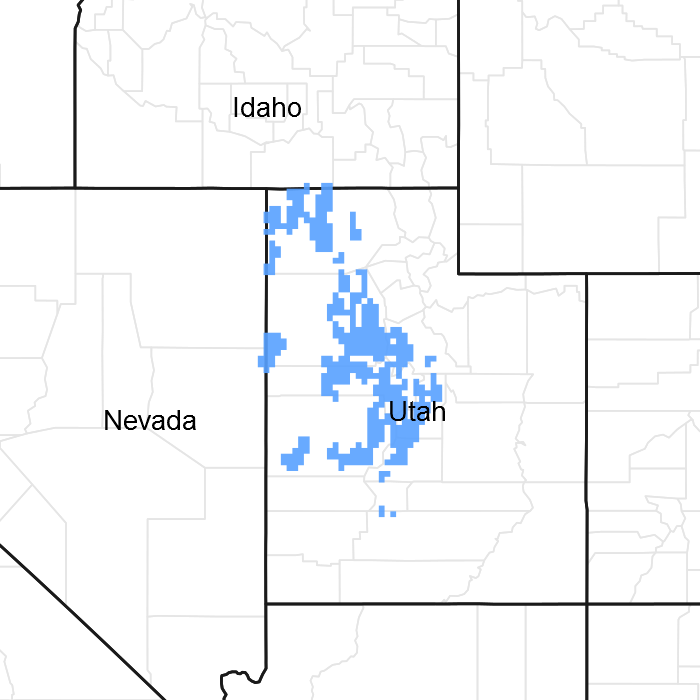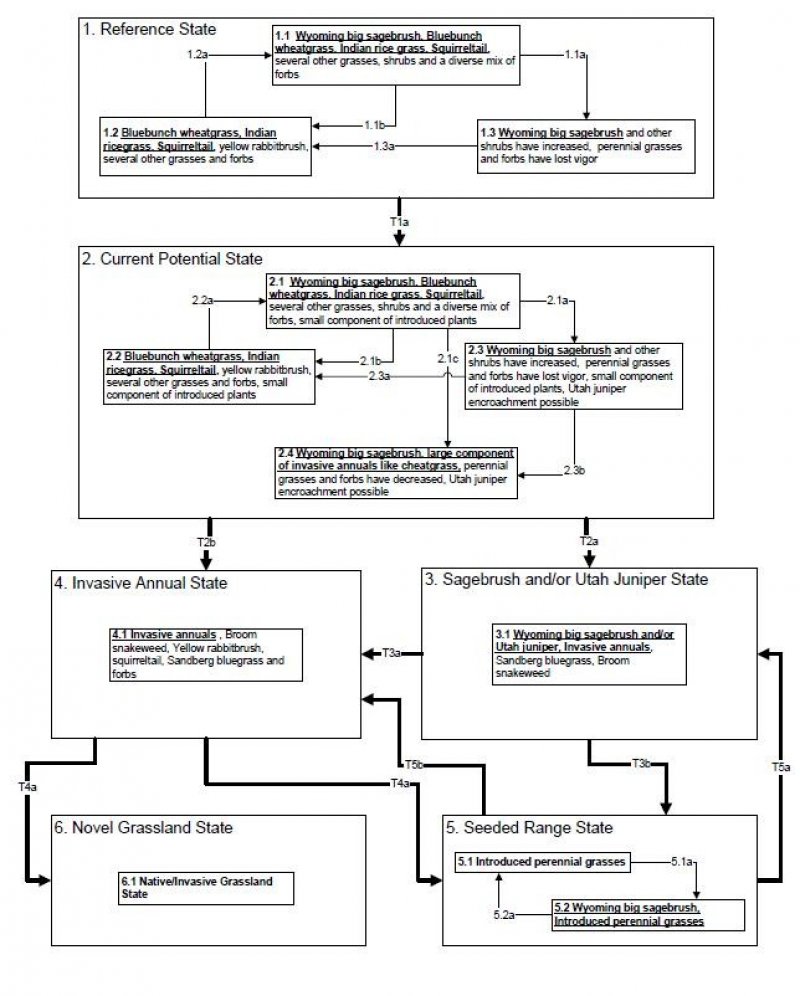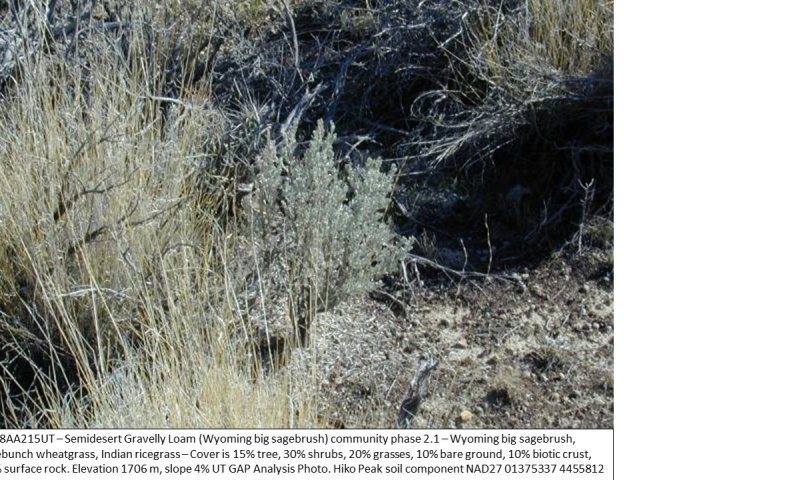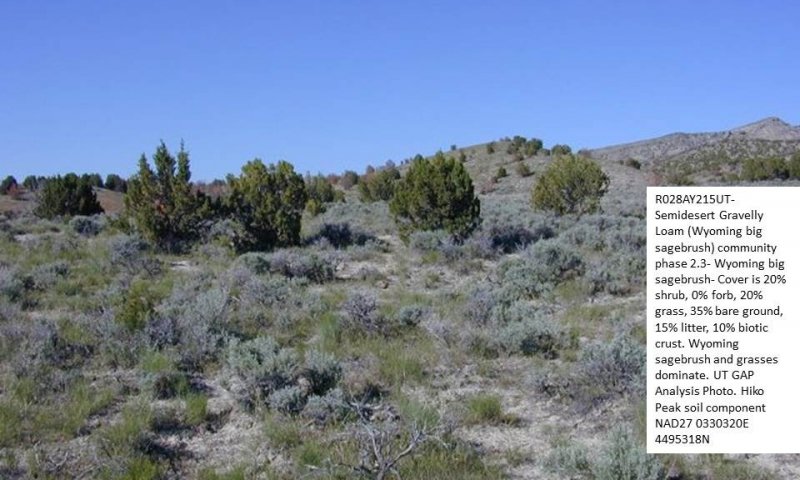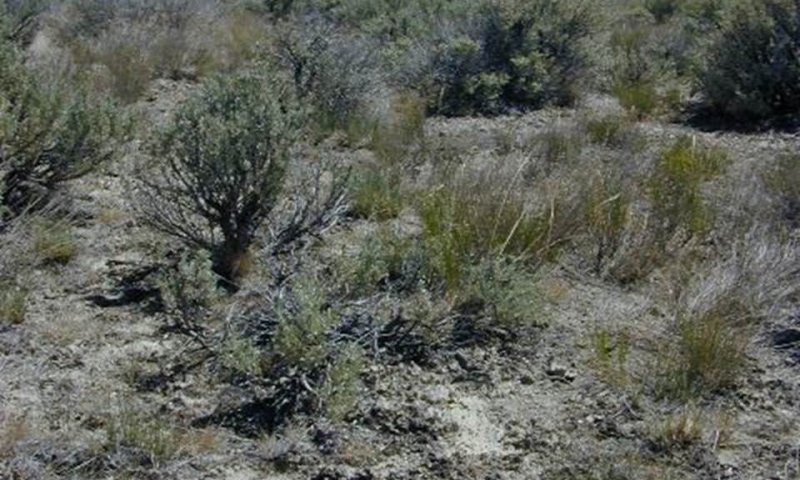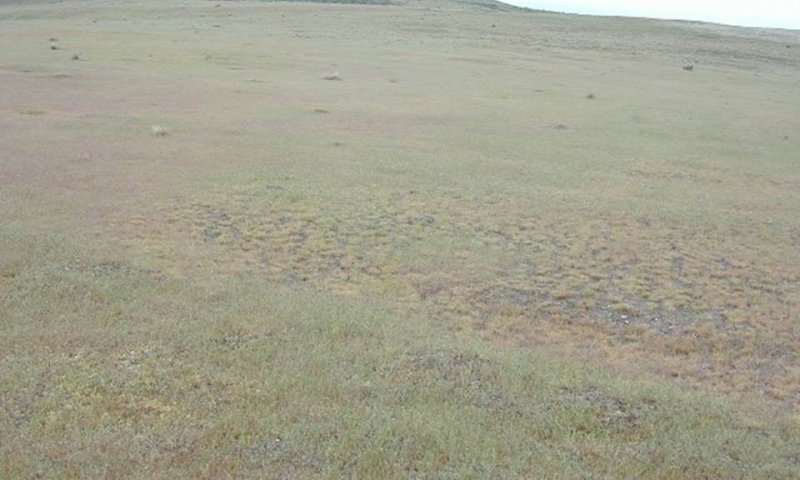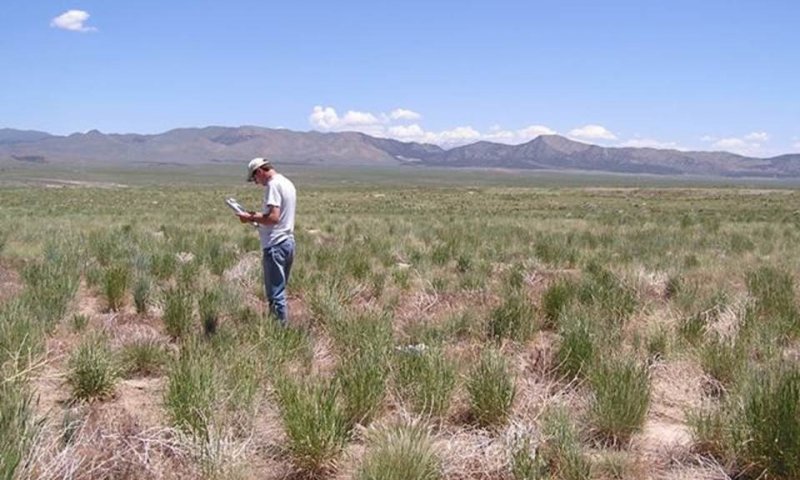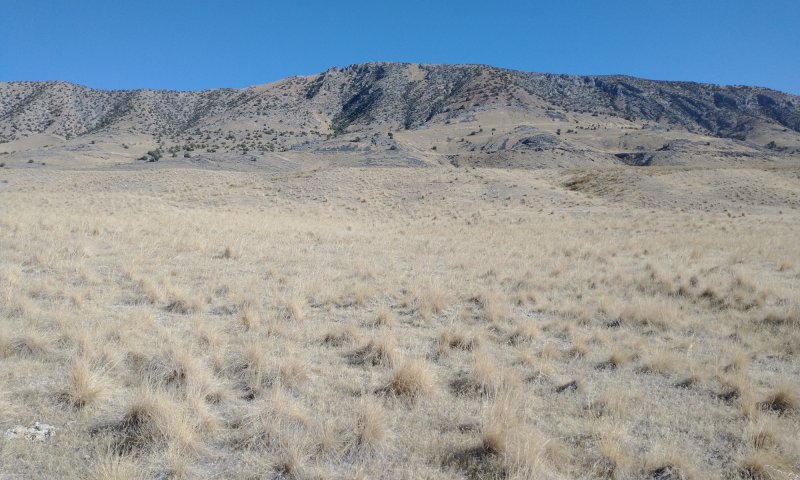Ecological dynamics
The Reference State is typically dominated by Wyoming big sagebrush and bluebunch wheatgrass. This site would cycle between three dominant plant community phases. One community phase would occur soon after a fire, with rabbitbrush and the perennial bunch grasses as the dominant plants and another community would develop in the absence of fire, with Wyoming big sagebrush cover increasing and reduced herbaceous cover.
The introduction of non-native species alters the trajectory of this site. Non-native species, such as cheatgrass and annual forbs, increase fine fuels and fire frequency. Once annuals become dominant, fire frequency continues to promote the invasive annual state.
This site has been successfully seeded to non-native bunchgrasses, reducing the fire return interval and allowing native shrubs to return to the system.
State 1
Reference State
The Reference State includes plant communities dominated by a diverse mixture of perennial grasses, Wyoming big sagebrush, and yellow rabbitbrush. These community phases occur depending on length time since a disturbance (fire, insects, drought, or over browsing) that removes Wyoming big sagebrush from the community. Adequate duration, timing, and intensity of grazing is required to maintain plant vigor and health of the plant community. Plant communities in the Reference State will consist of only native species.
Community 1.1
Wyoming big sagebrush, bluebunch wheatgrass, Indian ricegrass, Squirreltail, other perennial grasses
Community Phase 1.1 is dominated by Wyoming big sagebrush and bluebunch wheatgrass. Shadscale and winterfat are also commonly present in the shrub layer. Bluebunch wheatgrass and Indian ricegrass are the principle perennial grasses. Bottlebrush squirreltail is commonly present. Forbs include carpet phlox and scarlet globemallow. Percent composition by air-dry weight is 45 percent grass, 10 percent forbs, and 45 percent shrubs. Natural fire frequency is estimated to be 100 years.
Table 5. Annual production by plant type
| Plant type |
Low
(lb/acre) |
Representative value
(lb/acre) |
High
(lb/acre) |
| Grass/Grasslike |
203 |
349 |
450 |
| Shrub/Vine |
300 |
349 |
400 |
| Forb |
45 |
78 |
150 |
| Total |
548 |
776 |
1000 |
Table 6. Ground cover
| Tree foliar cover |
0%
|
| Shrub/vine/liana foliar cover |
15-25%
|
| Grass/grasslike foliar cover |
15-30%
|
| Forb foliar cover |
2-5%
|
| Non-vascular plants |
0%
|
| Biological crusts |
0%
|
| Litter |
0%
|
| Surface fragments >0.25" and <=3" |
0%
|
| Surface fragments >3" |
0%
|
| Bedrock |
0%
|
| Water |
0%
|
| Bare ground |
0%
|
Table 7. Canopy structure (% cover)
| Height Above Ground (ft) |
Tree |
Shrub/Vine |
Grass/
Grasslike |
Forb |
| <0.5 |
– |
– |
– |
– |
| >0.5 <= 1 |
– |
– |
– |
– |
| >1 <= 2 |
– |
– |
25-35% |
0-10% |
| >2 <= 4.5 |
– |
15-25% |
– |
– |
| >4.5 <= 13 |
– |
– |
– |
– |
| >13 <= 40 |
– |
– |
– |
– |
| >40 <= 80 |
– |
– |
– |
– |
| >80 <= 120 |
– |
– |
– |
– |
| >120 |
– |
– |
– |
– |
| Jan |
Feb |
Mar |
Apr |
May |
Jun |
Jul |
Aug |
Sep |
Oct |
Nov |
Dec |
| J |
F |
M |
A |
M |
J |
J |
A |
S |
O |
N |
D |
Community 1.2
Bluebunch wheatgrass, Indian ricegrass, squirreltail
Native perennial bunchgrasses dominate this post-fire community phase. Wyoming big sagebrush and shadscale decrease in the community. Winterfat has the ability to resprout and re-establish following a fire. Yellow rabbitbrush and horsebrush species (Nuttall, smooth and/or spiny) may increase significantly following fire. Fire tolerant shrubs typically persist as dominants in the community for 100 years or longer. Bluebunch wheatgrass and other cool season bunchgrasses flourish.
Community 1.3
Wyoming big sagebrush
Wyoming big sagebrush and shadscale increases significantly. Winterfat and yellow rabbitbrush may increase also. Shrubs become decadent due to age. Bluebunch wheatgrass, Indian ricegrass and other cool season bunchgrasses begin to lose vigor because of increased shrub competition and become dense with old vegetation. Western wheatgrass increases in herbaceous cover. Percent composition by air-dry weight is 30 percent grass, 10 percent forbs, and 60 percent shrubs.
Pathway 1.1b
Community 1.1 to 1.2
Recent fire occurrence, lightning or human caused (1 to 30 years). Site is properly grazed.
Pathway 1.1a
Community 1.1 to 1.3
Extended period of time without a major disturbance such as fire; insect damage; or prolonged drought. Fire frequency extends well beyond the 100 year average for the site.
Pathway 1.2a
Community 1.2 to 1.1
Normal fire frequency of 40 to 50 years returns on the site.
Pathway 1.3a
Community 1.3 to 1.2
Recent fire occurrence (1 to 30 years).
State 2
Current Potential State
The Current Potential State includes plant communities dominated by a diverse mixture of perennial grasses, a mixture of Wyoming big sagebrush, and perennial grasses, and a community dominated by Wyoming big sagebrush. These community phases occur depending on the time since a disturbance that kills Wyoming big sagebrush has occurred, such as fire, insects, or drought, and grazing that provides adequate duration, timing, and intensity that maintain plant vigor and health of the plant community.
Plant communities in this state can include native, acclimatized, naturalized, and invasive non-native species. The Current Potential State is irreversibly changed from the Reference State because the non-native species remain a permanent part of the community.
This plant community has the composition, structure and cover present that facilitates infiltration, nutrients are being cycled through deep rooted perennial grasses, forbs, and evergreen shrubs, and cool season energy capture throughout the entire growing season (March to October, when soil moisture is available) such that this plant community and site resiliency is maintained. With a lengthened fire return interval (greater than 60 years), an increase in sagebrush canopy occurs until sagebrush dominates resource use. This results in a decrease in vigor, cover and reproduction of perennial grasses, and may result in an increase of invasive annuals such as cheatgrass. This leads into transition T2b. With increased sagebrush cover, bare ground increases, infiltration decreases, and a reduction in the amount of nutrient cycling and energy capture.
Community 2.1
Wyoming big sagebrush, bluebunch wheatgrass, Indian ricegrass

Figure 12. Ground cover photo
Community Phase 2.1 is dominated by Wyoming big sagebrush. Shadscale and winterfat are also commonly present in the shrub layer. Bluebunch wheatgrass and Indian ricegrass are the principle perennial grasses. Bottlebrush squirreltail may also be present. Forbs include carpet phlox and scarlet globemallow. The community is dominated by native species, but may include acclimatized, naturalized and invasive non-native species. Percent composition by air-dry weight is 45 percent grass, 10 percent forbs, and 45 percent shrubs. Natural fire frequency is estimated to be 100 years.
Community 2.2
Bluebunch wheatgrass, Indian ricegrass

Figure 13. Bluebunch wheatgrass dominated phase
Wyoming big sagebrush and shadscale decrease in the community. Winterfat resprouts following the fire. Yellow rabbitbrush and horsebrush species (Nuttall, smooth and/or spiny) may increase significantly in the community following fire. Several native grasses dominate the understory. Fire tolerant shrubs typically persist as dominants in the community for 30 years or longer. This community is dominated by native species, but may include acclimatized, naturalized, and invasive non-native species.
Community 2.3
Wyoming big sagebrush

Figure 14. Wyoming big sagebrush dominated

Figure 15. Site located in Ibapah, UT before a harrow treatment

Figure 16. Wyoming sagebrush dominated with some Utah juniper

Figure 17. Some juniper encroachment on the site

Figure 18. Low grass cover

Figure 19. More juniper encroachment
Wyoming big sagebrush and shadscale increase in percent composition. Winterfat and Yellow rabbitbrush may increase also. Shrubs become decadent due to age. Bluebunch wheatgrass, Indian ricegrass and other cool season bunchgrasses begin to lose vigor because of improper grazing (including, season long overstocking, wrong season, etc.) and/or increased shrub competition and become dense with old vegetation. This community is dominated by native species, but may include acclimatized, naturalized, and invasive non-native species. Utah Juniper can encroach in this community phase but is small and low in cover. Percent composition by air-dry weight is 30 percent grass, 10 percent forbs, and 60 percent shrubs.
Community 2.4
Wyoming big sagebrush, native grasses, invasive annual grasses
Sagebrush is increasing in dominance and capturing site resources, reducing opportunity for perennial bunchgrasses to thrive. Fire frequency extends beyond the 100 year average for the site. A few Utah juniper may invade the site if a seed source is available in the upper precipitation ranges (10 to 12 inches).
An increase in sagebrush canopy until sagebrush dominates resource use, resulting in a decrease in vigor, cover and reproduction of perennial bunch grasses, and near co-dominance with invasive annuals such as cheatgrass. This community phase is at risk of transition to another state.
Pathway 2.1b
Community 2.1 to 2.2
Wyoming big sagebrush, bluebunch wheatgrass, Indian ricegrass
Bluebunch wheatgrass, Indian ricegrass
Fire removes non-sprouting shrubs from the community. Yellow rabbitbrush and/or horsebrush species become dominant. Recent fire occurrence (1 to 30 years).
Pathway 2.1a
Community 2.1 to 2.3
Wyoming big sagebrush, bluebunch wheatgrass, Indian ricegrass
Improper grazing (including season long, overstocking, wrong season, etc.) and/or drought remove annual and perennial fine fuels from the site lessening the potential for fire to occur. Fire frequency extends beyond the 40 to 50 year average for the site. Utah juniper may invade the site if a seed source is available and typically only in drainages.
Pathway 2.1c
Community 2.1 to 2.4
Wyoming big sagebrush, bluebunch wheatgrass, Indian ricegrass
Wyoming big sagebrush, native grasses, invasive annual grasses
Improper grazing (including season long, overstocking, continual spring grazing, etc.) and/or drought remove perennial grass facilitating an increase in invasive annual species.
Pathway 2.2a
Community 2.2 to 2.1
Bluebunch wheatgrass, Indian ricegrass
Wyoming big sagebrush, bluebunch wheatgrass, Indian ricegrass
Site is properly grazed for an extended period of time. Native perennial vegetation is recovering. Fire frequency returns to within the normal range for the state. 100 years or more without a fire occurrence (normal fire frequency).
Pathway 2.3a
Community 2.3 to 2.2
Bluebunch wheatgrass, Indian ricegrass
Fire removes non-sprouting shrubs from the community. Yellow rabbitbrush and/or horsebrush species become dominant. Recent fire occurrence (1 to 30 years).
Pathway 2.3b
Community 2.3 to 2.4
Wyoming big sagebrush, native grasses, invasive annual grasses
Continued lack of fire or other disturbance to reduce sagebrush cover. Continued grazing pressure on native bunch grasses.
State 3
Native Shrub/Invasive Annual State
Native shrubs such as Wyoming big sagebrush or rabbitbrush dominate the site. The dominance depends on time since fire. Wyoming big sagebrush is non-sprouting and will be killed by fire. Rabbitbrush can sprout after a fire and can become the dominant shrub. The Native Shrub/Invasive Annual State typically has invasive grasses and/or forbs as the dominant understory species. There may be a few native species remaining, but they do not dominate the plant community. Utah junipers may increase to occupy a significant portion of the over story, if a seed source is present. Wyoming big sagebrush dominates the shrub layer and may be decadent due to age. Bluebunch wheatgrass and other native bunchgrasses are significantly reduced due to increased shrub competition and/or heavy grazing pressure. Invasive annuals such as cheatgrass, annual mustards, and redstem storksbill dominate the understory. The occurrence of fire extends well beyond the normal period for the site.
Community 3.1
Wyoming big sagebrush and/or Utah juniper, invasive annuals

Figure 20. Wyoming sagebrush dominated phase

Figure 21. Utah juniper encroachment

Figure 22. Wyoming big sagebrush and cheatgrass dominated pha

Figure 23. Wyoming big sagebrush and cheatgrass dominated pha

Figure 24. Wyoming big sagebrush dominated phase

Figure 25. Unburned Oak City watershed

Figure 26. Unburned Oak City watershed
Wyoming sagebrush is typically the dominant shrub in this community phase. Where Utah juniper has invaded, Wyoming big sagebrush and other shrubs decline, otherwise they dominate the community. Winterfat is dead or dying. Remaining perennial herbaceous vegetation is mostly found only in protected locations under shrubs. Invasive, non-native grasses and weeds including cheatgrass, annual mustards, redstem storksbill, etc. dominate the understory.
State 4
Invasive Annual State
Invasive grasses and forbs dominate the Invasive Annual State. This may occur under a shortened fire return interval which excludes native shrubs by frequent burning or this may occur with repeated improper grazing, or a combination of the two. Bluebunch wheatgrass and other native bunchgrasses are significantly reduced due to increased shrub competition and/or heavy grazing pressure. Only remnant perennial species remain. Highly combustible fine fuels from invasive annuals to dominate the community. Fire is common. Fire frequency is 10 to 30 years.
Community 4.1
Invasive annuals

Figure 27. Broom snakeweed dominated after a fire.

Figure 28. Invasive annual dominated phase.

Figure 29. Invasive annuals dominated phase.

Figure 30. Invasive annuals and broom snakeweed dominated site.

Figure 31. Cheatgrass and redstem storks bill dominated site.

Figure 32. Invasive annual forbs and grasses dominated site.
Invasive annuals dominate this community phase. If shrubs are present, yellow rabbitbrush dominates the shrub layer. Remaining winterfat is mostly dead. Horsebrush species (Nuttall, smooth, and spiny) can also be plentiful if conditions are right. Fire tolerant shrubs may persist as dominants with fire periods reoccurring at intervals of 5 to 30 years. Broom snakeweed may be a dominant episodic species when conditions are favorable. Only remnant perennial bunchgrasses remain, if any; invasive annuals including cheatgrass, annual mustards, redstem storksbill, etc. dominate the understory.
State 5
Seeded Range State
The Seeded Range State is seeded to rangeland species that are composed of mostly introduced species. Unwanted trees and/or shrubs are reduced but they may occupy a portion of the site through natural regeneration. Invasive annual grasses and weedy forb species primarily, cheatgrass and various annual mustards, may be present in the seeding, but do not dominate.
Community 5.1
Introduced perennial grasses

Figure 33. Crested wheatgrass seeded site
This community is seeded to rangeland species that is composed of mostly introduced species. Unwanted trees and/or shrubs are reduced but they may occupy a portion of the site through natural regeneration. Invasive annual grasses and weedy forb species primarily, cheatgrass and various annual mustards, may be present in the seeding, but do not dominate. Range seedings, when healthy, are usually resistant to fire.
Community 5.2
Wyoming big sagebrush, introduced perennial grasses

Figure 34. Wyoming big sagebrush and introduced perennial gra

Figure 35. Ground cover photo of phase

Figure 36. Mature Wyoming big sagebrush dominated site with i
This community includes the dominance of introduced perennial understory. Native shrubs are re-establishing.
Pathway 5.1a
Community 5.1 to 5.2
Introduced perennial grasses
Wyoming big sagebrush, introduced perennial grasses
Seeding is not well established; continued improper grazing (including season long, overstocking, wrong season, etc.); and/or drought reduces any perennial grasses established. Highly combustible fine fuels from invasive annuals shorten the fire frequency.
Pathway 5.2a
Community 5.2 to 5.1
Wyoming big sagebrush, introduced perennial grasses
Introduced perennial grasses
Site receives good grazing management. Mechanical, chemical, biological or fire disturbances reduce the woody vegetation components of the community. Perennial herbaceous vegetation very slowly recovers.
State 6
Novel Grassland State
The Novel Grassland State is co-dominated by perennial natives Aristida purpurea and Sporobolus cryptandrus, and the non-native annual Bromus tectorum. Aristida purpurea and Sporobolus cryptandrus are warm season bunch grasses that occupy very small components of the historic plant community, but for reasons not yet know, are the dominant perennial grasses in this state.
Community 6.1
Native/Invasive Grassland
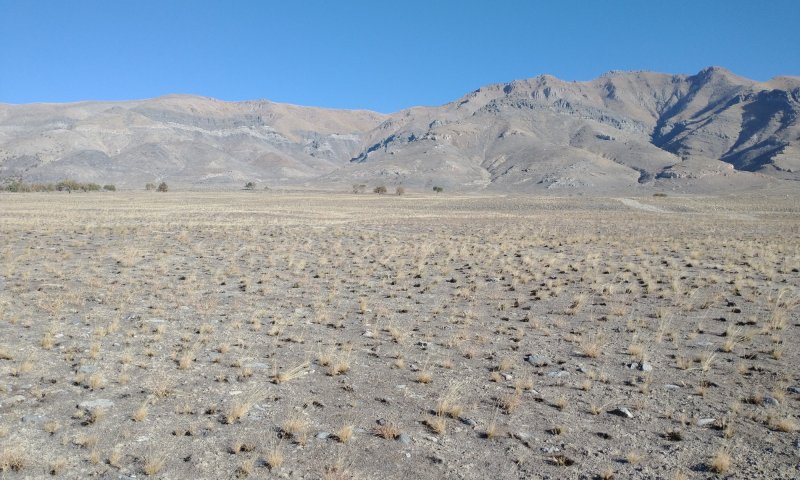
Figure 37. Tooele County, Utah
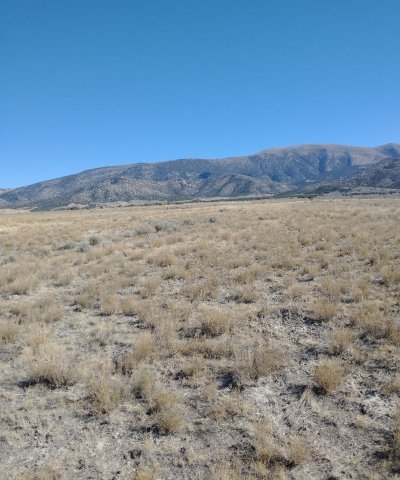
Figure 38. Tooele County, Utah
The Native/Invasive Grassland Threeawn / Cheatgrass co-dominated plant community is co-dominated by perennial natives Aristida purpurea and Sporobolus cryptandrus, both warm season bunch grasses that occupy very small components of the historic plant community, and Bromus tectorum.
Transition T1a
State 1 to 2
The threshold is crossed when there is an introduction of non-native species, primarily cheatgrass and various annual mustards, that become established in the community.
Transition T2a
State 2 to 3
Native Shrub/Invasive Annual State
Sustained, long-term improper grazing (including season long, overstocking, wrong season, etc.); and/or prolonged drought. Lengthening of the fire return interval.
Transition T2b
State 2 to 4
Long-term improper grazing (including season long, overstocking, wrong season, etc.) and/or prolonged drought; shortened fire return interval.
Transition T3a
State 3 to 4
Native Shrub/Invasive Annual State
Long-term improper grazing (including season long, overstocking, wrong season, etc.) and/or prolonged drought; shortened fire frequency.
Transition T3b
State 3 to 5
Native Shrub/Invasive Annual State
Seeding of mostly introduced species.
Transition T4a
State 4 to 5
Seeding of mostly introduced species.
Transition T4b
State 4 to 6
The mechanism for this transition is unknown. Some studies suggest that intense grazing may cause the shift in the plant community.
Transition T5a
State 5 to 3
Native Shrub/Invasive Annual State
Long-term improper grazing (including season long, overstocking, wrong season, etc.) and/or prolonged drought; lengthened fire frequency.
Transition T5b
State 5 to 4
Long-term improper grazing (including season long, overstocking, wrong season, etc.) and/or prolonged drought; shortened fire return interval allows the vegetation on the site to be dominated by invasive annuals.


